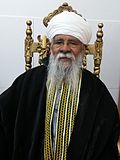Beta Israel
The Beta Israel, or Ethiopian Jews, are a Jewish diaspora group that lived for thousands of years in the territory of the Kingdom of Aksum and its successor the Ethiopian Empire, which is currently divided between the Amhara Region and Tigray Region in modern-day Ethiopia. After the founding of the State of Israel in 1948, most of the Beta Israel immigrated there or were evacuated through several initiatives by the Israeli government. Historically, Beta Israel lived in northern and northwestern Ethiopia, where they were spread out across more than 500 small villages over a wide territory, alongside predominantly Christian and Muslim populations. Most of them were concentrated mainly in what is today North Gondar Zone, Shire Inda Selassie, Wolqayit, Tselemti, Dembia, Segelt, Quara, and Belesa.
The Beta Israel appeared to have been isolated from the more mainstream Jewish communities for at least a millennium, and practiced a non-Talmudic form of Judaism that is similar in some respects to Karaite Judaism. The religious practices of Israeli Beta Israel are referred to as Haymanot. Having suffered persecution in Ethiopia, a significant portion of the Beta Israel community was forced into Christianity during the 19th and 20th centuries; those who converted to Christianity then came to be known as the Falash Mura. The larger Christian Beta Abraham community is considered to be a crypto-Jewish offshoot of the Beta Israel community.
The Beta Israel first made extensive contact with other Jewish communities in the late 20th century, after which a comprehensive rabbinic debate ensued over their Jewishness. Following halakhic and constitutional discussions, Israeli authorities decided in 1977 that the Beta Israel qualified on all fronts for the Israeli Law of Return. Thus, the Israeli government, with support from the United States, began a large-scale effort to conduct transport operations and bring the Beta Israel to Israel in multiple waves. These activities included Operation Brothers, which evacuated the Beta Israel community in Sudan between 1979 and 1990 (including Operation Moses in 1984 and Operation Joshua in 1985), and Operation Solomon in 1991.
By the end of 2008, there were 119,300 Ethiopian Jews living in Israel, including nearly 81,000 born in Ethiopia and about 38,500 (about 32% of the Ethiopian Jewish community in Israel) born in Israel with at least one parent born in Ethiopia or Eritrea (formerly a part of Ethiopia). At the end of 2019, there were 155,300 Jews of Ethiopian descent in Israel. Approximately 87,500 were born in Ethiopia, and 67,800 were born in Israel with parents born in Ethiopia. The Ethiopian Jewish community in Israel is mostly composed of Beta Israel (practicing both Haymanot and Rabbinic Judaism), and to a smaller extent, of Falash Mura who left Christianity and began practicing Rabbinic Judaism upon their arrival to Israel.
Beta Israel Media
Raphael Hadane, the former Liqa Kahenat (High priest) of Beta Israel in Israel
Public appeal of the Chief Rabbinate of Israel to save the Jews of Ethiopia, 1921, signed by Abraham Isaac Kook and Jacob Meir
Migration Map of Beta Israel
Israeli PM Yitzhak Shamir greets new immigrants from Ethiopia, 1991
Israeli Border Policeman
The Beta Israel Memorial Aliya in Kiryat Gat





